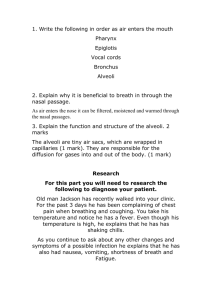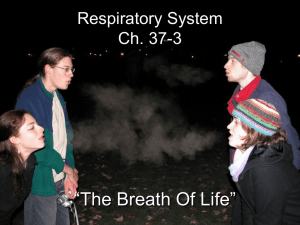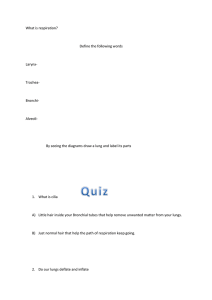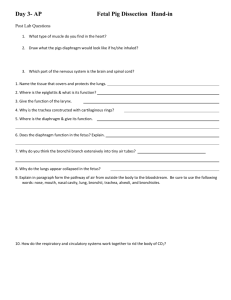Respiratory System in Humans Provides a large surface area for the
advertisement
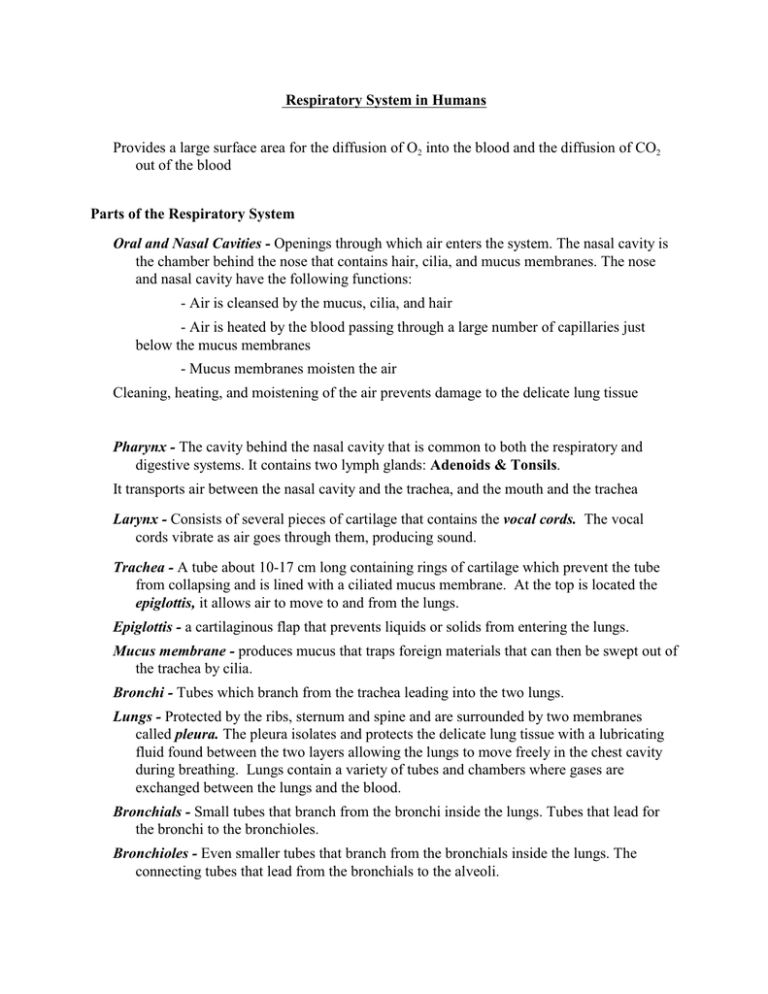
Respiratory System in Humans Provides a large surface area for the diffusion of O2 into the blood and the diffusion of CO2 out of the blood Parts of the Respiratory System Oral and Nasal Cavities - Openings through which air enters the system. The nasal cavity is the chamber behind the nose that contains hair, cilia, and mucus membranes. The nose and nasal cavity have the following functions: - Air is cleansed by the mucus, cilia, and hair - Air is heated by the blood passing through a large number of capillaries just below the mucus membranes - Mucus membranes moisten the air Cleaning, heating, and moistening of the air prevents damage to the delicate lung tissue Pharynx - The cavity behind the nasal cavity that is common to both the respiratory and digestive systems. It contains two lymph glands: Adenoids & Tonsils. It transports air between the nasal cavity and the trachea, and the mouth and the trachea Larynx - Consists of several pieces of cartilage that contains the vocal cords. The vocal cords vibrate as air goes through them, producing sound. Trachea - A tube about 10-17 cm long containing rings of cartilage which prevent the tube from collapsing and is lined with a ciliated mucus membrane. At the top is located the epiglottis, it allows air to move to and from the lungs. Epiglottis - a cartilaginous flap that prevents liquids or solids from entering the lungs. Mucus membrane - produces mucus that traps foreign materials that can then be swept out of the trachea by cilia. Bronchi - Tubes which branch from the trachea leading into the two lungs. Lungs - Protected by the ribs, sternum and spine and are surrounded by two membranes called pleura. The pleura isolates and protects the delicate lung tissue with a lubricating fluid found between the two layers allowing the lungs to move freely in the chest cavity during breathing. Lungs contain a variety of tubes and chambers where gases are exchanged between the lungs and the blood. Bronchials - Small tubes that branch from the bronchi inside the lungs. Tubes that lead for the bronchi to the bronchioles. Bronchioles - Even smaller tubes that branch from the bronchials inside the lungs. The connecting tubes that lead from the bronchials to the alveoli. Alveoli - Grape-like clusters of sacs that provide a large surface area for gas exchange. Found at the end of bronchioles, these microscopic, one-cell thick, grape-like air sacs provide a moist surface area surrounded by capillaries that creates an ideal site for gas exchange between the air in the lungs and the blood in the capillaries. Diaphragm - Sheet of muscle that separates the thorax (chest) and abdominal cavities. The movement of this muscle is chiefly responsible for creating the mechanics of breathing. Inspiration (inhale) : Diaphragm muscle contracts Expiration (exhale) : Diaphragm muscle relaxes Exhalation (Expiration): Air leaves the lungs Six steps to the process: 1. Rib muscles and diaphragm relax 2. Ribs move down and in 3. Diaphragm moves up 4. Thorax decreases in size or volume 5. Pressure increases in the thorax because of the decrease in volume. This results in a higher pressure inside the thorax than found outside the thorax. 6. Air rushes out of the lungs Rate of Breathing Breathing is an involuntary response Controlled by a section of the brain called the medulla oblongata Sends impulses to the intercostal muscles of the ribs and diaphragm causing them to contract producing inspiration When this impulse stops, the intercostal muscles and diaphragm relax producing expiration The amount of CO2 in the blood determines the rate of breathing. There are two sensors located in the circulatory system to measure the CO2 content of the blood: 1. Carotid artery in the neck 2. Aorta leading from the left ventricle of the heart When CO2 levels are high, breathing rate is fast When CO2 levels are low, breathing rate is slow Breathing rates vary with age and physical activity Stages of Respiration 1. Breathing 2. External respiration 3. Internal respiration # 2 &3 all involve gas exchange through concentration gradients 4. Cellular respiration External Respiration Exchange of gases between the alveoli of the lungs and the blood Occurs by diffusion: O2 diffuses into the blood from the alveoli CO2 diffuses into the alveoli from the blood Gas Transport Transportation of gas between the lungs and body cells Gases enters the blood and combine with the protein hemoglobin found in the RBCs Lung to Body cells O2 enters and combines with the hemoglobin forming oxyhemoglobin Body cells to Lung CO2 enters and combines with the hemoglobin forming carboxyhemoglobin CO2 also combines with water in the RBC and in the plasma forming carbonic acid Internal Respiration Exchange of gases between the blood and the cells of the body Occurs by diffusion: O2 diffuses into the body cells from the blood CO2 diffuses into the blood from the body cells Cellular Respiration Release of energy within a cell through a series of chemical reactions Glucose is converted to ATP Can occur aerobically or anaerobically See previous unit for details Diseases of the Respiratory System Bronchitis Inflammation of the bronchial passages Two forms: Acute Severe form which involves an infection of the air passages Chronic Less severe form which involves an irritation of the air passages Signs and symptoms include fever, chest pain, severe coughing, and often secretion of sputum Asthma Caused by the constriction of bronchial passages and swelling of their mucus linings Triggered by hypersensitivity to various agents within an individual’s environment Attack begins with pressure in the chest, feeling of suffocation, with severe bouts of uncontrollable coughing and the secretion of a thick mucoid sputum Emphysema A progressive disease in which the tissues of the lungs lose their elasticity The volume of air the lungs are able to handle continually decreases Deterioration of the lungs is permanent and irreversible Symptoms include severe coughing, shortness of breath, and wheezing Develops into difficulty in breathing, disability, and death Influenza A viral infection of the respiratory tract, especially the trachea Commonly called the flu Reduces a person’s resistance making them susceptible to further infections such as pneumonia Symptoms include sore throat, nasal discharge, fever, chills, headache, aching of muscles and joints, upset stomach Common cold A viral infection of the upper respiratory tract Symptoms include sneezing, headaches, sore throats, and nasal discharge Carbon Monoxide Poisoning Carbon monoxide is a chemical compound consisting of one atom of carbon and one atom of oxygen (CO) Odorless and tasteless gas Produced when organic compounds are burned with an insufficient air supply When inhaled it combines with the hemoglobin in the RBCs preventing absorption of oxygen Symptoms are mild and include nausea, headache, or fatigue Treatment involves removing the individual from the source of CO. Perform mouth to mouth resuscitation if necessary


